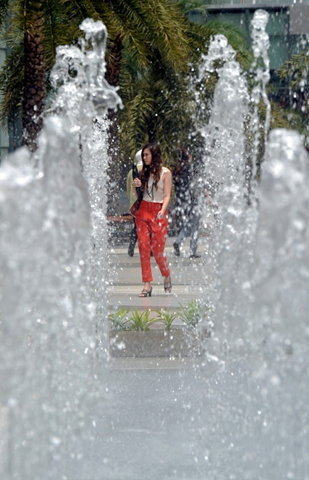Bangkok heatwave stokes debate over mega-city planning as climate warms
By Amy Sawitta Lefevre, with additional reporting by Enrico Dela Cruz and Manuel Mogato in Manila, David Fogarty in Singapore and Stuart Grudgings in Kuala Lumpur; Editing by Alan Raybould and Jeremy Laurence
4 May 2012 BANGKOK (Reuters) – Five months after the worst floods in half a century, the Thai capital is facing a heat wave with temperatures at three-decade highs, stoking debate over chaotic urban planning that blights many of Southeast Asia’s overcrowded capitals. The daily average high in Bangkok in April was 40.1 Celsius (104.2 Fahrenheit), the Meteorological Department says, prompting warnings from authorities for residents to be alert for heat-related ailments. Critics say the heat has been exacerbated by poor urban planning in the fast-growing city of 12 million people – from a thinning of trees by city workers, often to accommodate electrical power lines, to heat-trapping building designs and a small number of parks. “It is a factor,” Prawit Jampanya, director of the Central Weather Forecast division at the Meteorological Department, said, referring to the lack of green spaces in trapping Bangkok’s mercury-pumping heat. “Having trees does help to relieve poor air quality and urban heat traps,” he said. […] In the Philippines, 13 million people are sweltering in the congested capital, Manila. High-rise condominiums and commercial buildings have sprouted up and the population is growing fast. April 30 was the warmest day of the year at 36.6 Celsius, a bit lower than the all-time high of 38.6 Celsius on 7 May 1915. In 2009, Typhoon Ketsana brought massive rainfall and floods into Manila, killing nearly 250 people. That highlighted the impact of climate change plus a lack of urban planning. “We can’t do anything to expand green areas. What we are trying to prevent is informal settlers occupying the remaining green spaces,” said Francis Tolentino, chairman of Metro Manila Development Authority. […] The heat coincides with drought in 50 out of Thailand’s 77 provinces, plus an increase in man-made and natural fires, just months after the worst floods in more than 50 years, which devastated seven big industrial estates in the centre. The country’s biggest industrial complex, Map Ta Phut, is in the east and escaped the flooding, but a lack of rainfall is beginning to worry its 147 businesses. A local reservoir is only half-full and the director of the estate, Pratheep Aeng-Chuan, said officials would meet the Royal Irrigation Department and the provincial Department of Disaster Prevention and Mitigation on May 14 to discuss the situation.

BRILLIANT!! Plant More Trees – they will absorb the pollution.